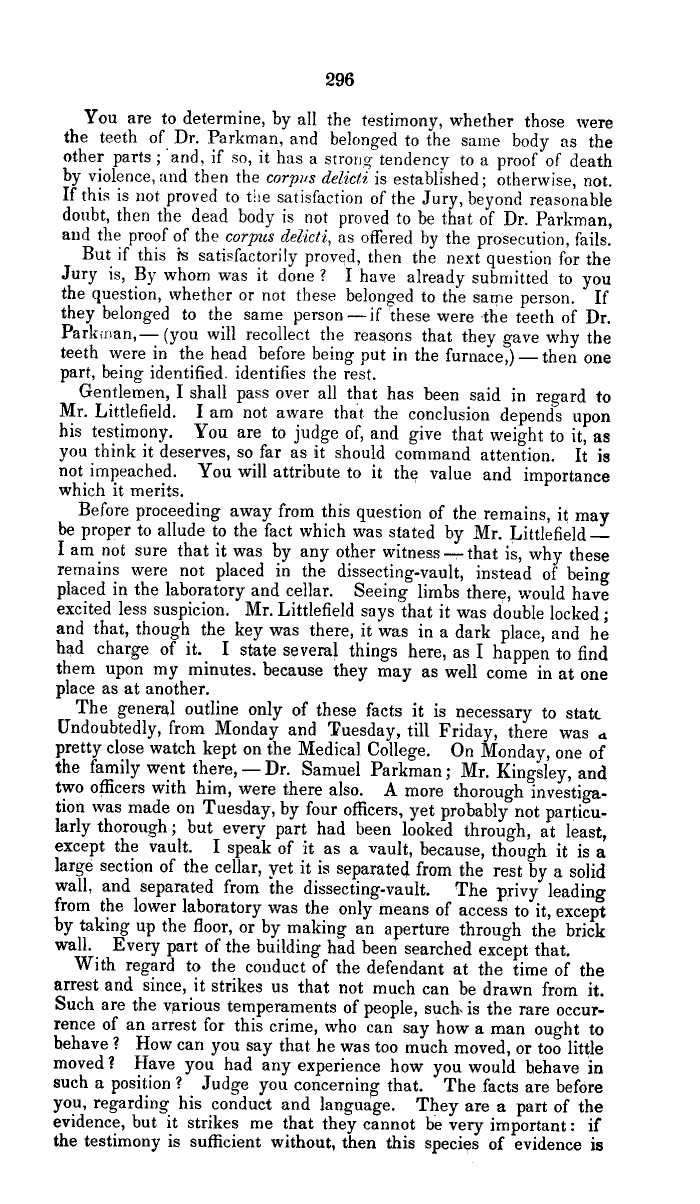|
296
You are to determine, by all the testimony, whether those were
the teeth of Dr. Parkman and belonged to the same body as the
other parts ; and, if so, it has a strong tendency to a proof of death
by violence, and then the corpus delicdi is established; otherwise, not.
If this is not proved to t:ie satisfaction of the Jury, beyond reasonable
doubt then the dead body is not proved to be that of Dr. Parkman,
and the proof of the corpus delacti, as offered by the prosecution, fails.
But if this is satisfactorily proved, then the next question for the
Jury is, By whom was it done ? I have already submitted to you
the question, whether or not these belonged to the same person. If
they belonged to the same person-if these were the teeth of Dr.
Parkalan,- (you will recollect the reasons that they gave why the
teeth were in the head before being put in the furnace,)-then one
part, being identified. identifies the rest.
Gentlemen, I shall pass over all that has been said in regard to
Mr. Littlefield. I am not aware that the conclusion depends upon
his testimony. You are to judge of, and give that weight to it, as
you think it deserves, so far as it should command attention. It is
not impeached. You will attribute to it the value and importance
which it merits.
Before proceeding away from this question of the remains, it, may
be proper to allude to the fact which was stated by Mr. Littlefield-
I am not sure that it was by any other witness-that is, why these
remains were not placed in the dissecting-vault, instead of being
placed in the laboratory and cellar. Seeing limbs there, would have
excited less suspicion. Mr. Littlefield says that it was double locked;
and that, though the key was there, it was in a dark place, and he
had charge of it. I state several things here, as I happen to find
them upon my minutes. because they may as well come in at one
place as at another.
The general outline only of these facts it is necessary to statc
Undoubtedly, from Monday and Tuesday, till Friday, there was a
pretty close watch kept on the Medical College. On Monday, one of
the family went there, - Dr. Samuel Parkman ; Mr. Kingsley, and
two officers with him, were there also. A more thorough investiga.
tion was made on Tuesday, by four officers, yet probably not paTticu-
larly thorough; but every part had been looked through, at least,
except the vault. I speak of it as a vault, because, though it is a
large section of the cellar, yet it is separated from the rest by a solid
wall, and separated from the dissecting-vault. The privy leading
from the lower laboratory was the only means of access to it, except
by taking up the floor, or by making an aperture through the brick
wall. Every part of the building had been searched except that.
With regard to the conduct of the defendant at the time of the
arrest and since, it strikes us that not much can be drawn from it.
Such are the various temperaments of people, such, is the rare occur-
rence of an arrest for this crime, who can say how a man ought to
behave ? How can you say that. he was too much moved, or too little
moved? Have you had any experience how you would behave in
such a position ? Judge you concerning that. The facts are before
you regarding his conduct and language. They are a part of the
evidence, but it strikes me that they cannot be very important: if
the testimony is sufficient without, then this species of evidence is
|

